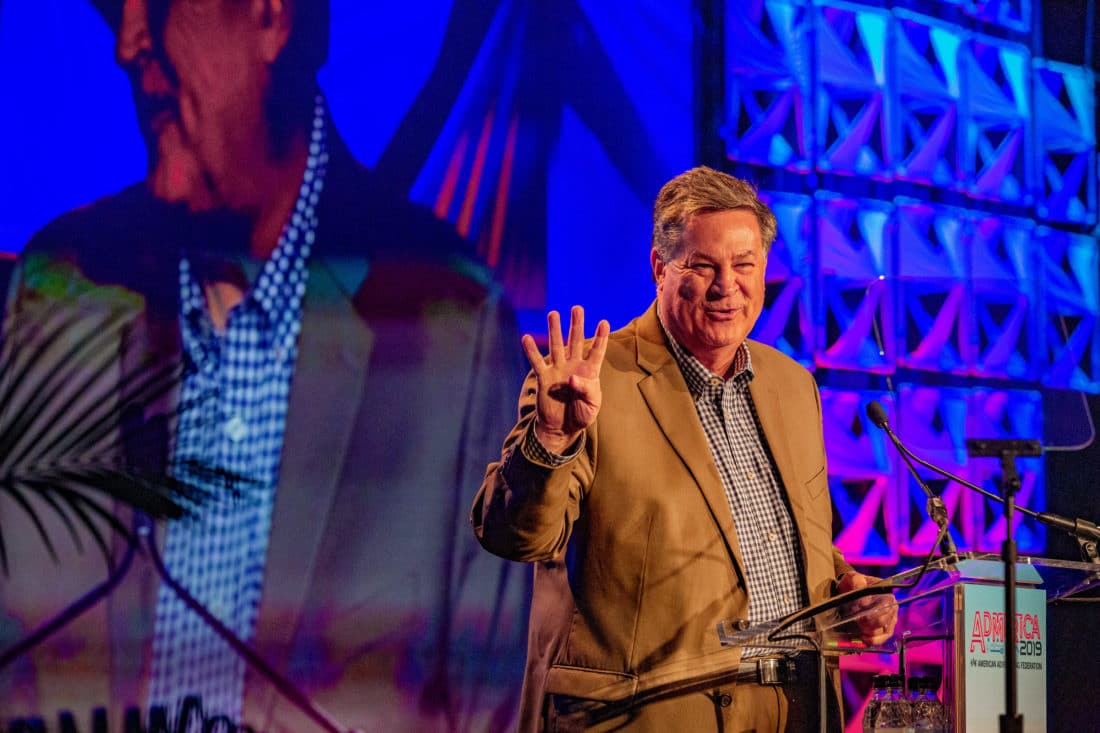The new CEO on the advertising industry, storytelling and the purpose-driven brand.
From picking up ad copy as a newspaper intern to producing Emmy Award-winning TV commercials, Steve Pacheco is bringing his relentless passion for advertising to his new role as president and CEO of the American Advertising Federation. From the heyday of print journalism to today’s reliance on big data, Pacheco continues to believe in the timeless importance of personal connection.
Last week, his first on the job, Pacheco hosted ADMERICA, AAF’s annual conference, which took place in Hollywood, Fla. Following four days of award shows and sessions on topics such as bias in AI and Gen Z’s Finstagrams, Pacheco sat down for an exclusive interview with Velocitize.
What was your first job, and how did it shape the person you are today?
As a journalism major at the University of Memphis in the 1980s, I had a job as an intern working for the advertising departments of the Memphis Commercial Appeal and the Press-Scimitar, both owned by E.W. Scripps Company at the time. [The Press-Scimitar went out of business in 1983.]
I was basically a glorified messenger, picking up ad copy and checks and delivering tear sheets of ads that had run. That got to me, as a news and advertising junkie, to see how the sausage is made. I knew I wanted to be part of it because putting a fresh paper together every day is quite an accomplishment, and teaches you a lot about teamwork and diverse personalities. I turned that internship into a full-time job, and wound up selling ads and writing ad copy.
In the digital space, who’s creating this type of personal connection?
Just this week, IKEA launched a Pinterest campaign in partnership with media agency Wavemaker, one of AAF’s corporate sponsors. The retailer is transforming its print catalogues into digital product recommendations based on an individual’s answers to a style questionnaire, where only the IKEA products would fit. In effect, they’re creating an individualized mini-catalogue. That’s powerful.
You worked at FedEx from 1996 to 2017, where you last served as advertising and sponsorships director. What were some of your best experiences?
The advertising industry is the greatest in the world, because it attracts talented, creative, deeply curious people. And those are my kind of people and yes, there’s been lots and lots of characters.
I’ve had the honor and privilege to work on 12 Super Bowl commercials. You know, there’s lots of money on the line and lots of people waiting and watching to see how well you did. That was the highlight, being associated with that kind of pressure. We won an Emmy for the 2006 campaign about a caveman trying to send a stick. We beat out the Budweisers, Visas and the Gillettes of the world and punched well above our weight. It was a simple story well told and had lots of emotional appeal.
Advertisers are facing serious brand-safety issues, pulling ads from questionable media outlets containing offensive content and, at times, hateful speech. As the former CMO of a wetlands non-profit, do you think cause marketing is advertising’s safe place?
Mission-focused and purpose-driven brands and organizations are particularly well positioned for growth in today’s marketplace. Especially when you consider how much is expected by brands and organizations from today’s demanding consumers.
I have seen, firsthand, how brands and companies are focusing on adding shareholder value and enhancing public perception by partnering with organizations considered change agents – the communities rallying around a cause that have their own publications and means of distribution. It’s an intersection of cause, community, brand.
At Ducks Unlimited, we had over 50 corporate partners in North America that developed marketing and communication programs leveraging the DU marks and logo to amplify their own efforts around conservation and the environment. These partners ranged from Fortune 500 companies to national retailers to packaged goods and more. They all saw the value in aligning with an organization widely recognized as the worldwide leader in their space – in this case, wetlands conservation and restoration of healthy habitats.
You’re someone who values human relationships. Can you offer advice on how to preserve them in an era of tech neck?
I turn off notifications, which are a huge distraction. And I’m a bit old school in that regard. It’s getting harder and harder for folks to do this, especially the younger generation. If there’s somebody in front of you, they deserve all your time, and you need to be present. I’ll put down my phone — now, I’m a big believer in that. If you’re not really present, I think it shows that you’re not fully leaning in and listening, you know, passionately. So I’m really good with that.
Speaking of the younger generation, the AAF has college chapters. You yourself were part of one at the University of Memphis. What can we expect from the AAF now that you’re at the helm?
The most pressing issue in our industry is generating future talent. The AAF doesn’t get enough respect or awareness for what we do in that area – developing the next generation of advertising practitioners – literally, from high school to college to your first real job, all the way to the Hall of Fame. This summer, we’re doing an AdCamp in Atlanta for students between 10th and 12th grade, and trying to get people energized and excited about the profession of advertising.
I really do believe that the American Advertising Federation’s best days are ahead, because we can harness the power of grassroots efforts in our 250 clubs across North America, and nearly 200 college chapters. They’re positioned to take “the unifying voice of advertising,” our tagline, to the masses.
Banner photo credit: Jim Clark
www.iamjimclark.com
